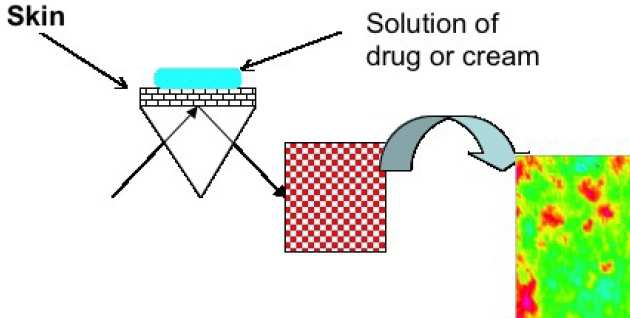Skin and transdermal drug delivery
EPSRC grant (EP/D502721) "Spectroscopic Imaging of Skin and its Application to (trans) dermal delivery (PI: S. G. Kazarian)
 We have developed applications of advanced spectroscopic methods (FTIR imaging and confocal Raman microscopy) for studying (trans)dermal delivery. These methods were combined with the use of multivariate chemometrics for enhanced data analysis. The research was conducted in collaboration with groups specializing in drug delivery and pharmaceutical analysis from the London School of Pharmacy and the University of Greenwich. The programme of work has explored applications of FTIR imaging in micro- and macro ATR imaging modes to skin samples in contact with formulations.
We have developed applications of advanced spectroscopic methods (FTIR imaging and confocal Raman microscopy) for studying (trans)dermal delivery. These methods were combined with the use of multivariate chemometrics for enhanced data analysis. The research was conducted in collaboration with groups specializing in drug delivery and pharmaceutical analysis from the London School of Pharmacy and the University of Greenwich. The programme of work has explored applications of FTIR imaging in micro- and macro ATR imaging modes to skin samples in contact with formulations.
The macro ATR-FTIR imaging approach was also combined with a controlled environment cell to demonstrate the possibility of obtaining chemical images of SC exposed to a wide range of relative humidities and diffusion of ethanol through the SC tissue with a specially designed liquid cell. The effect of water vapour in the SC on the distribution of other components in the SC was studied.
The macro ATR-FTIR imaging approach was also combined with a controlled environment cell to demonstrate the possibility of obtaining chemical images of SC exposed to a wide range of relative humidities and diffusion of ethanol through the SC tissue with a specially designed liquid cell. The effect of water vapour in the SC on the distribution of other components in the SC was studiedMacro-ATR imaging was applied for the first time to study in situ the dynamic process of permeation of model formulations through the skin. ATR-FTIR imaging has been applied to measure, in situ, the diffusion of a model drug, through the outer layer of human skin (stratum corneum (SC)). The analysis of the images provided a strong correlation between the distribution of lipid and drug, while ethanol appeared homogenously distributed in the SC. These results show the ability of FTIR imaging to measure affinities of drug and solvent to the lipid rich and lipid poor skin domains during the permeation. This information is useful for understanding drug diffusion pathways through the SC. We have also demonstrated the first example of high-throughput studies of transdermal permeation through skin using ATR-FTIR imaging. The permeation of several samples has been studied simultaneously.
Key References
- Chan K. L. A., Kazarian S. G., Chemical Imaging of Stratum Corneum under Controlled Humidity with ATR FT-IR Method, Journal of Biomedical Optics 12 (2007) 044010-1 - 044010-10.
- Boncheva M, Tay, F. H., Kazarian S. G., Application of attenuated total reflection Fourier transform infrared imaging and tape-stripping to investigate the 3D distribution of exogenous chemicals and the molecular organization in Stratum Corneum, J. Biomed. Opt. 13 (2008) 064009.
- Andanson J. M., Chan K. L. A., Kazarian S. G., High-throughput spectroscopic imaging applied to permeation through the skin, Applied Spectroscopy 63 (2009) 512-517.
- Andanson J.M., Hadgraft J., Kazarian S. G., In situ permeation study of drug through the stratum corneum using ATR-FTIR spectroscopic imaging, J. Biomed. Opt. 14 (2009) 034011.
- Kazarian S. G., Chan K. L.A. ATR-FTIR spectroscopic imaging: recent advances and applications to biological systems Analyst (2013) 138 (7), 1940 - 1951 (doi)


